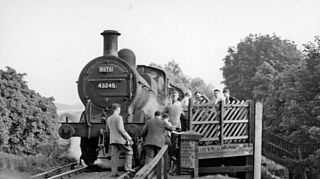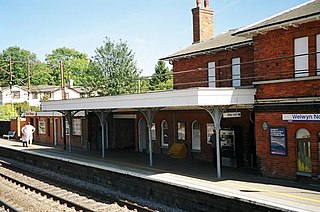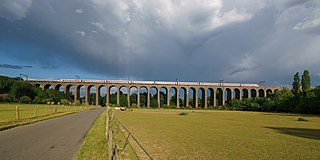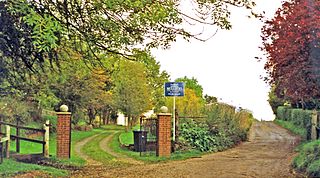Notes
Coordinates: 51°47′51″N0°10′51″W / 51.7974°N 0.1809°W
Attimore Hall Halt | |
|---|---|
| General information | |
| Location | Hertfordshire England |
| Platforms | 1 |
| Other information | |
| Status | Disused |
| History | |
| Original company | Great Northern Railway |
| Key dates | |
| May 1905 | Station opens as Attimore Hall Halt |
| 1 July 1905 | Closed for passengers |
| 4 May 1964 | closed for goods |
Attimore Hall Halt was a halt station on the Great Northern Railway in Hertfordshire, England. [1] The station was built near what is now the town of Welwyn Garden City, which would be established in 1920, after the station closed. It was on the Hertford and Welwyn Junction Railway.
The station opened to the public in May 1905, although it was a quiet station, which resulted in the closure one month later. The station was demolished.
| Preceding station | Disused railways | Following station | ||
|---|---|---|---|---|
| Welwyn Junction | Great Northern Railway Hertford and Welwyn Junction Railway | Hatfield Hyde Halt |
Coordinates: 51°47′51″N0°10′51″W / 51.7974°N 0.1809°W

The Nickey line is a disused railway that once linked the towns of Hemel Hempstead and, initially, Luton but later Harpenden via Redbourn, in Hertfordshire, England. The course of most of the railway has been redeveloped as a cycle and walking path, and is part of the Oxford to Welwyn Garden City route of the National Cycle Network. It is approximately nine miles (14 km) long.

Welwyn Garden City railway station serves the town of Welwyn Garden City in Hertfordshire, England. It is 20 miles 25 chains from London King's Cross on the East Coast Main Line. Train services are currently provided by Thameslink and Great Northern.

Welwyn North railway station serves the villages of Digswell and Welwyn in Hertfordshire, England. The station is located 22 miles (35 km) north of London King's Cross, on the East Coast Main Line. Train services are currently provided by Thameslink and Great Northern.

The Digswell Viaduct, also called Welwyn Viaduct, is a railway viaduct that carries the East Coast Main Line over the River Mimram in the county of Hertfordshire in England. A prominent local landmark, it is located between Welwyn Garden City and Digswell. It is just to the south of Welwyn North railway station.

Dunstable Town, also known as Dunstable Church Street, was a railway station on the Great Northern Railway's branch line from Welwyn which served Dunstable in Bedfordshire from 1858 to 1965. Against a background of falling passenger numbers and declining freight returns, the station closed to passengers in 1965 and to goods in 1964, a casualty of the Beeching Axe. The station site is now in use as part of the Luton to Dunstable Busway.

Luton Bute Street railway station was the first to be built in Luton, England. It was opened by the Luton, Dunstable and Welwyn Junction Railway Company in 1858, which was an extension of the Welwyn and Hertford Railway. The track to Welwyn was completed in 1860 and taken over by the Great Northern the following year.

The Alban Way is a traffic free multi-user route along a former railway line in Hertfordshire, England, that has been constructed along the route of the former Hatfield to St Albans railway line. It runs from St Albans, close to St Albans Abbey railway station and the site of Roman Verulamium, through Fleetville and Smallford to Hatfield, ending close to Hatfield railway station. It is 7.5 miles (12.1 km) long.
Poyle for Stanwell Moor Halt railway station was on the outskirts of London, on the now closed line of the Staines and West Drayton Railway.

Sherrardspark Wood is a 74.9 hectare biological site of Special Scientific Interest in Welwyn Garden City, Hertfordshire. The site was notified in 1986 under the Wildlife and Countryside Act 1981.

Spencer Road Halt railway station was a halt on the Woodside and South Croydon Railway opened in 1906 and closed on 15 March 1915.

Ayot was a railway station serving Ayot St Peter near Welwyn Garden City in Hertfordshire, England. It was on the branch line to Dunstable.

East Minster is a disused railway station serving Minster on the Isle of Sheppey. It opened in 1902 and closed in 1950.

The Dunstable Branch Lines were railway branch lines that joined the English town of Dunstable to the main lines at Leighton Buzzard and Welwyn. The two lines were under separate ownership and joined just east of the Dunstable North station.

Wheathampstead railway station was a railway station serving Wheathampstead on the Great Northern Railway branch line to Dunstable. While little of it remains now, east of Wheathampstead is the Ayot Greenway which follows what was the line towards Welwyn Garden City.
Godnow Bridge railway station was a small railway station on the line between Doncaster and Keadby, between Medge Hall Halt and Crowle. The area is shown on old maps as "Godknow Bridge". It was opened with the line from Thorne (Old) railway station in September 1859 and closed in 1917.

Chaul End was a temporary railway halt on the Great Northern Railway's branch line from Welwyn which served a munitions factory near Luton during the First World War. The station site has been reused as part of the Luton to Dunstable Busway.
Hatfield Hyde Halt was a halt-layout railway station. The station was part of the Hertford and Welwyn Junction Railway, near the garden city of Welwyn, which was established in 1920, by which time Hatfield Hyde Halt had long been closed.

The Hertford and Welwyn Junction Railway is a former railway in Hertfordshire, England, which merged in 1858 with the Luton, Dunstable and Welwyn Railway to form the Hertford, Luton and Dunstable Railway, which was then taken over by the Great Northern Railway in 1861.
The Hertford, Luton and Dunstable Railway was a railway affiliated to the Great Northern Railway. It was formed when the Hertford and Welwyn Junction Railway merged with the Luton, Dunstable and Welwyn Junction Railway, partly opened in the same year. The merger and change of title took place in 1860. The line joined the Dunstable branch of the London and North Western Railway at Dunstable.

Hertingfordbury railway station was a station at Hertingfordbury, Hertfordshire, England, on the Hertford and Welwyn Junction Railway. It was a passenger station from 1858 until 18 June 1951 and as of 2016 the station building was a private residence. It had a single platform and a small goods yard to the east and was finally closed to all traffic in 1962.